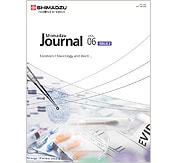Vol.6, Issue2-October 2018 CONTENT
Featuring Forensics/Toxicology
 |
Shimadzu Journal Vol.6, Issue2-October 2018 (1,710 KB) Forensics / Toxicology
|
 |
[Insight from Customer] Interview with Prof. Franck SAINT-MARCOUX from Limoges University Hospital (Page 22-23) We interviewed Prof. Franck SAINT-MARCOUX (PharmD, PhD), Full Professor of Toxicology, Clinical and Forensic Toxicology Unit, Pharmacology and Toxicology Department, Limoges University Hospital, France. He outlines his research in general and the research he is conducting at European Innovation Center with Shimadzu. |
 |
[Toxicology] Measurements of drugs of abuse are needed in multiple contexts within clinical and forensic toxicology. In this report, a fully automated extraction method was carried out by the programmable liquid handler CLAM-2000, directly coupled to LCMS-8060 system for the determination of multiple amphetamines, cocaine derivatives and opioids. |
 |
[Forensics] Two methods were developed to quantify two common groups of drugs plaguing the MDME laboratory. The first was a group consisting of the most commonly abused drugs found in MDME cases and included: cocaine, cocaethylene, benzoylecgonine, morphine, codeine, 6MAM, and alprazolam. |
 |
[Interview]
Interview with Dr. George Hime from Miami-Dade County Medical Examiner's office (Page 29-30) We interviewed Dr. George Hime, the manager and assistant director of the Toxicology laboratory at the Miami-Dade Medical Examiner’s office. He talks about the challenge that the forensic toxicologist faces in today’s society and prospects in the future.
|
 |
Shimadzu Selection (Page 31-32)
Shimadzu selected 16 articles for this issue. They derive from application news and technical reports related to forensics and toxicology, and utilize a variety of Instruments we produce. Cutting-edge researches are also included. |
 |
[Forensics]
Forensic Toxicology in Racing Animals (Page 33-41)
Amongst toxicologists, there has always been some debate over whether or not the detection of drugs and other residues in samples collected from racing animals and human athletes is a form of forensic toxicology or falls into some other category. |
 |
[Topics] Shimadzu Corporation is proud to announce its 100th anniversary of scale manufacturing, which follows the 100th anniversary of manufacturing testing machines, celebrated last year. We have been contributing to society with technologies since our foundation in 1875. In 1918, we started our balances and scales business with the launch of an experimental scale. |
 |
[Topics] Two Shimadzu analytical instruments, the AIM-9000 infrared microscope and the IRSpirit Fourier transform infrared spectrophotometer, have been awarded the Red Dot Design Award for Product Design 2018, a renowned design prize in Germany. |
 |
[Topics] The Shimadzu Innovation Centre (SIC) has found a valid and feasible way to both develop its own commercial products and engage in collaborative research. Recently, SIC worked on water contamination caused by an outburst of toxic algal bloom in collaboration with members of the National University of Singapore (NUS). |
 |
[New Products] Nexera Mikros (Micro Flow LC-MS), Smart Forensic Database Ver. 2 for GC-MS/MS, UV-1900, LCMS-9030 (Q-TOF) (Page 45) |



